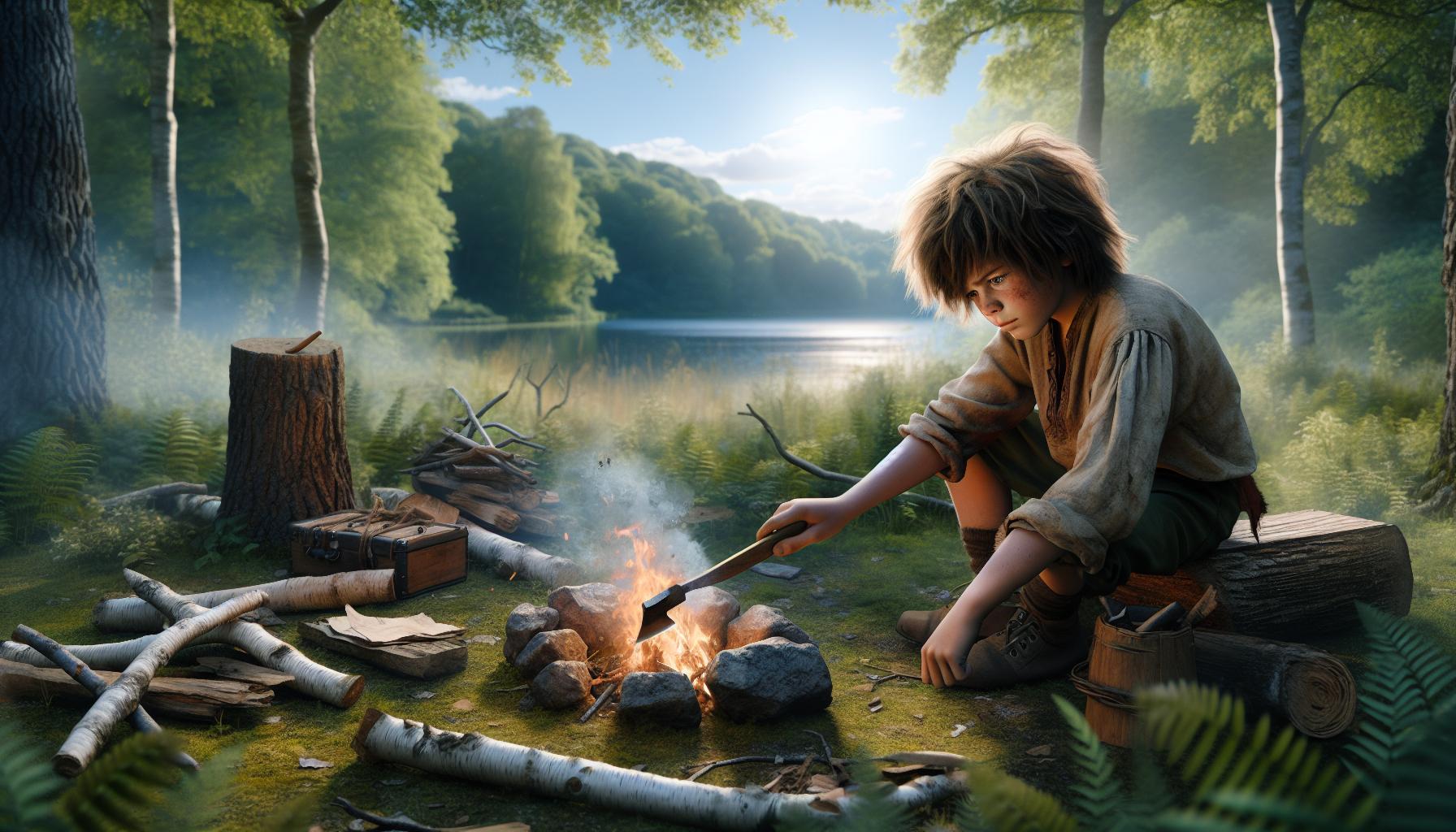I’ve always been captivated by survival stories, but Gary Paulsen’s “Hatchet” stands out as a masterpiece that changed my perspective on human resilience. This gripping tale follows 13-year-old Brian Robeson’s fight for survival after a plane crash leaves him stranded in the Canadian wilderness with nothing but a hatchet.
When I first read this Newbery Honor-winning novel, I couldn’t help but be drawn into Brian’s 54-day journey of self-discovery and survival. The way Paulsen weaves together themes of independence, perseverance and coming-of-age resonates deeply with readers of all ages. Through vivid descriptions and intense emotional moments I found myself experiencing every challenge alongside Brian making this more than just another survival story.
Key Takeaways
- Brian Robeson, a 13-year-old boy, survives 54 days in the Canadian wilderness with only a hatchet after a plane crash
- The story demonstrates remarkable character development as Brian transforms from a helpless city teenager into a resourceful survivalist through learning essential skills like fire-making, shelter building, and food gathering
- Key survival milestones include creating fire, building shelter, developing hunting techniques, and discovering an emergency survival pack in the crashed plane
- The novel earned a Newbery Honor in 1988 and has sold over 2 million copies worldwide, becoming a significant piece of young adult literature
- Themes of self-reliance, perseverance, and coming-of-age are woven throughout the narrative, making it both an adventure story and a powerful character study
Book:b9h8dlcle58= Hatchet
Gary Paulsen’s “Hatchet” introduces 13-year-old Brian Robeson, who survives a single-engine Cessna plane crash in the Canadian wilderness with only a hatchet as his tool. The 195-page novel, published in 1987, earned the Newbery Honor and has sold over 2 million copies worldwide.
The plot centers on Brian’s journey to visit his father in the Canadian oil fields when the pilot experiences a fatal heart attack. After crash-landing in a lake, Brian faces numerous survival challenges:
- Learning to make fire with his hatchet
- Finding edible food sources like raspberries turtle eggs
- Building a shelter from tree branches pine needles
- Creating weapons for hunting fish rabbits
- Defending against wildlife including a moose bear
Key survival milestones in Brian’s 54-day ordeal:
| Day | Event |
|---|---|
| 1 | Plane crash survival initial shelter construction |
| 8 | First successful fire-starting attempt |
| 15 | Development of hunting spear fishing techniques |
| 35 | Discovery of emergency survival pack in plane |
| 54 | Rescue by passing plane |
The narrative employs a third-person limited perspective focusing on Brian’s thoughts emotions physical experiences. This viewpoint allows readers to connect with his psychological transformation from a city boy to a skilled survivalist. The hatchet serves as both a practical tool symbolic representation of Brian’s resilience throughout the story.
Two central conflicts drive the plot:
- External: Brian versus wilderness environment
- Internal: Brian’s emotional struggle with his parents’ divorce secret
- Dense Canadian forest
- L-shaped lake
- Rocky ridges
- Berry patches
- Wildlife habitats
Brian Robeson’s Journey to Survival

Brian’s transformation from a scared 13-year-old crash survivor to a resourceful wilderness survivor spans 54 grueling days in the Canadian wilderness. His journey demonstrates the remarkable adaptability of the human spirit in extreme conditions.
The Plane Crash
The single-engine Cessna crashes into the L-shaped lake after the pilot suffers a fatal heart attack. Brian manages to surface from the submerged plane with only his hatchet, attached to his belt by the pilot before takeoff. The crash scene unfolds in vivid detail: the terrifying descent, the impact with the water at 80 miles per hour, and Brian’s desperate swim to the surface. His initial moments on shore involve intense physical pain, disorientation, and the crushing realization of his isolation.
Living Alone in the Canadian Wilderness
Brian’s daily survival routine evolves through painful trial and error in the unfamiliar wilderness:
- Making fire using his hatchet to strike sparks from a stone
- Building a shelter against a rock face using tree branches
- Foraging for edible plants such as gut berries raspberries
- Hunting small game with a self-crafted bow arrow
- Creating tools from available materials like tree bark spears
His encounters with wildlife shape his wilderness education:
- Surviving a porcupine attack in his shelter
- Escaping a moose charge in the lake
- Enduring a skunk spray near his camp
- Defending against a bear at his food storage area
| Challenge | Duration | Outcome |
|---|---|---|
| Initial hunger | 3 days | Discovers gut berries |
| Fire making | 2 days | Creates spark with hatchet |
| Shelter building | 1 day | Constructs lean-to shelter |
| Clean water | 4 hours | Finds lake water source |
Essential Survival Skills Portrayed

Brian Robeson’s survival in “Hatchet” demonstrates critical wilderness skills that transform him from an inexperienced city boy to a resourceful survivor. The novel illustrates practical survival techniques through Brian’s trial-and-error learning process.
Making Fire
Brian’s mastery of fire-making evolves from frustrating failures to consistent success using his hatchet and a flint stone. He creates sparks by striking his hatchet against a stone at precise angles, collecting fine birch bark as tinder. The novel details his fire-maintenance technique:
- Gathering dry wood in three sizes: twigs, finger-thick sticks larger branches
- Creating a spark nest using shredded birch bark
- Building a tepee structure with smallest materials at center
- Protecting the flames from wind rain using a rock formation
Finding Food and Shelter
Brian develops systematic approaches to secure sustenance shelter in the wilderness:
Food Sources:
- Gut berries (raspberries chokecherries) for immediate energy
- Fish caught through spear fishing in the L-shaped lake
- Bird eggs found in riverside nests
- Foolbirds (ruffed grouse) hunted using careful observation
- Stone ridge shelter against a rock face
- Woven wall panels using tree branches
- Elevated sleeping platform to avoid ground moisture
- Strategic positioning facing the lake for visibility safety
The novel emphasizes Brian’s methodical learning process, documenting specific techniques that prove essential for his 54-day survival. Each skill builds upon previous experiences, creating a comprehensive survival toolkit.
Character Development and Growth

Brian’s emotional growth parallels his physical transformation throughout his 54-day wilderness ordeal. His initial response to the crash reflects typical teenage behavior: panic, self-pity, and anger. Three key phases mark his character evolution:
Mental Resilience
Brian develops a problem-solving mindset after surviving the initial shock of the crash. He learns to control his emotions by adopting what he calls “tough hope,” focusing on immediate challenges rather than dwelling on rescue possibilities. This mental shift occurs after Day 7 when he successfully creates fire, marking his first significant triumph over despair.
Self-Discovery
The isolation forces Brian to confront his inner struggles, particularly:
- His parents’ divorce (The Secret)
- His role in family dynamics
- His physical limitations
- His urban dependencies
His self-awareness increases through:
- Analyzing mistakes
- Learning from failures
- Developing patience
- Accepting responsibility
Emotional Maturity
Brian’s emotional transformation manifests in multiple ways:
- Moving from reactive to proactive behavior
- Developing gratitude for small victories
- Finding peace in solitude
- Accepting nature’s rhythms
Key developmental milestones include:
| Day | Event | Growth Impact |
|---|---|---|
| 1-7 | Initial survival phase | Basic adaptation |
| 8-22 | Tool creation period | Problem-solving skills |
| 23-35 | Food gathering mastery | Self-reliance |
| 36-54 | Environmental integration | Complete transformation |
By Day 47, Brian demonstrates remarkable emotional intelligence, maintaining composure during life-threatening situations like the moose attack. His reactions evolve from panic-driven responses to calculated decisions based on accumulated wilderness knowledge. This profound character development transforms him from a dependent teenager into a self-reliant individual capable of surviving extreme circumstances.
Themes of Self-Reliance and Perseverance
Self-reliance emerges as a central force in Brian’s wilderness survival journey, transforming him from a dependent city teenager into a resourceful survivor. His initial helplessness after the plane crash evolves into strategic problem-solving skills through 3 key developments:
- Creating fire using his hatchet
- Building a sustainable food gathering system
- Establishing a secure shelter against wildlife
Perseverance manifests through Brian’s response to 5 significant setbacks:
- Failing 20 times before successfully making fire
- Recovering from a devastating tornado destroying his shelter
- Continuing after a moose attack leaves him injured
- Rebuilding tools after losing them to various accidents
- Maintaining hope despite failed rescue attempts
The combination of these themes creates a powerful narrative structure, demonstrated in this progression table:
| Timeline | Self-Reliance Development | Perseverance Challenge |
|---|---|---|
| Days 1-7 | Learning fire-making | Overcoming initial despair |
| Days 8-20 | Developing hunting techniques | Surviving food poisoning |
| Days 21-35 | Crafting complex tools | Rebuilding after tornado |
| Days 36-54 | Creating backup systems | Recovering from injuries |
Brian’s internal dialogue shifts from self-doubt to confidence through his experiences with both triumph and failure. His mindset evolves to embrace solitude and self-sufficiency, particularly evident in 4 pivotal moments:
- Realizing help isn’t coming after the rescue plane passes
- Choosing to restart after the tornado destroys everything
- Deciding to hunt larger game despite previous failures
- Creating contingency plans for winter survival
The hatchet serves as both a practical tool and a symbol of Brian’s growing independence, enabling him to:
- Shape his environment
- Defend against threats
- Create hunting weapons
- Maintain his survival systems
This dual focus on self-reliance and perseverance drives Brian’s character development, demonstrating how survival challenges forge resilience and independence.
Impact and Literary Recognition
“Hatchet” earned a Newbery Honor Medal in 1988, marking its significance in children’s literature. The novel’s impact extends beyond its initial release, with over 2 million copies sold globally across 17 languages.
Educational institutions embraced “Hatchet” as required reading in middle school curricula across the United States. Teachers report using the novel to teach:
- Survival skills analysis
- Character development tracking
- Environmental awareness concepts
- Problem-solving strategies
- Literary devices identification
The novel’s influence sparked four companion books:
| Book Title | Publication Year | Main Focus |
|---|---|---|
| Brian’s Winter | 1996 | Alternative ending scenario |
| Brian’s Return | 1999 | Brian’s readjustment struggles |
| Brian’s Hunt | 2003 | Return to wilderness adventure |
| The River | 1991 | Government survival training |
Literary critics praise “Hatchet” for:
- Authentic wilderness depiction
- Psychological depth in character development
- Clear writing style
- Educational value
- Universal themes
The book received recognition from multiple organizations:
| Award/Recognition | Year | Organization |
|---|---|---|
| Newbery Honor | 1988 | American Library Association |
| Dorothy Canfield Fisher Award | 1989 | Vermont Department of Libraries |
| California Young Reader Medal | 1990 | California Reading Association |
“Hatchet” influenced the young adult survival fiction genre, inspiring authors to create realistic wilderness narratives. The novel’s success established Gary Paulsen as a leading voice in young adult literature, contributing to his legacy of over 200 published works.
Masterpiece
“Hatchet” stands as a masterpiece that transformed young adult literature through its raw portrayal of survival and self-discovery. I’ve found that Brian’s journey from helpless teenager to skilled survivalist resonates deeply with readers of all ages.
The novel’s enduring success stems from its authentic blend of practical survival skills and emotional growth. I believe it’s this combination that has secured its place in classrooms and libraries worldwide.
Through Brian’s story I’ve witnessed how determination resilience and adaptability can overcome seemingly impossible odds. Gary Paulsen’s vivid storytelling ensures that “Hatchet” will continue inspiring readers to find their inner strength when facing life’s challenges.

